语言学---第一章知识框架
语言学知识点概括

语言学知识点概括Chapter one Introduction一、定义1.语言学LinguisticsLinguistics is generally defined as the scientific study of language.2.普通语言学General LinguisticsThe study of language as a whole is often called General linguistics.3.语言languageLanguage is a system of arbitrary vocal symbols used for human communication.语言是人类用来交际的任意性的有声符号体系。
4.识别特征Design FeaturesIt refers to the defining poperties of human language that distinguish it from any animal system of communication.语言识别特征是指人类语言区别与其他任何动物的交际体系的限定性特征。
Arbitrariness任意性Productivity多产性Duality双重性Displacement移位性Cultural transmission文化传递⑴arbitrarinessThere is no logical connection between meanings and sounds.P.S the arbitrary nature of language is a sign of sophistication and it makes it possible for language to have an unlimited source of expressions⑵ProductivityAnimals are quite limited in the messages they are able to send.⑶DualityLanguage is a system, which consists of two sets of structures ,or two levels.⑷DisplacementLanguage can be used to refer to contexts removed from the immediate situations of the speaker.⑸Cultural transmissionHuman capacity for language has a genetic basis, but we have to be taught and learned the details of any language system. this showed that language is culturally transmitted. not by instinct. animals are born with the capacity to produce the set of calls peculiar to their species.5.语言能力CompetenceCompetence is the ideal user‘s knowledge of the rul es of his language.6.语言运用performancePerformance is the actual realization of this knowledge in linguistic communication.语言运用是所掌握的规则在语言交际中的体现。
(完整word版)语言学概论知识点
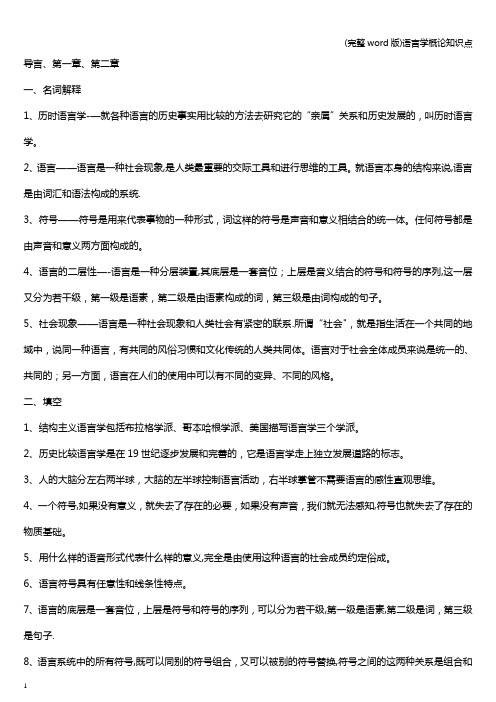
导言、第一章、第二章一、名词解释1、历时语言学-—就各种语言的历史事实用比较的方法去研究它的“亲属”关系和历史发展的,叫历时语言学。
2、语言——语言是一种社会现象,是人类最重要的交际工具和进行思维的工具。
就语言本身的结构来说,语言是由词汇和语法构成的系统.3、符号——符号是用来代表事物的一种形式,词这样的符号是声音和意义相结合的统一体。
任何符号都是由声音和意义两方面构成的。
4、语言的二层性—-语言是一种分层装置,其底层是一套音位;上层是音义结合的符号和符号的序列,这一层又分为若干级,第一级是语素,第二级是由语素构成的词,第三级是由词构成的句子。
5、社会现象——语言是一种社会现象和人类社会有紧密的联系.所谓“社会",就是指生活在一个共同的地域中,说同一种语言,有共同的风俗习惯和文化传统的人类共同体。
语言对于社会全体成员来说是统一的、共同的;另一方面,语言在人们的使用中可以有不同的变异、不同的风格。
二、填空1、结构主义语言学包括布拉格学派、哥本哈根学派、美国描写语言学三个学派。
2、历史比较语言学是在19世纪逐步发展和完善的,它是语言学走上独立发展道路的标志。
3、人的大脑分左右两半球,大脑的左半球控制语言活动,右半球掌管不需要语言的感性直观思维。
4、一个符号,如果没有意义,就失去了存在的必要,如果没有声音,我们就无法感知,符号也就失去了存在的物质基础。
5、用什么样的语音形式代表什么样的意义,完全是由使用这种语言的社会成员约定俗成。
6、语言符号具有任意性和线条性特点。
7、语言的底层是一套音位,上层是符号和符号的序列,可以分为若干级,第一级是语素,第二级是词,第三级是句子.8、语言系统中的所有符号,既可以同别的符号组合,又可以被别的符号替换,符号之间的这两种关系是组合和聚合。
9、组合是指符号与符号相互之间在功能上的联系,聚合是指符号在性质上的归类。
三、判断正误(正确的打钩,错误的打叉)1、文字是人类最重要的交际工具。
自考语言学概论知识网络图第一章 语言和语言学
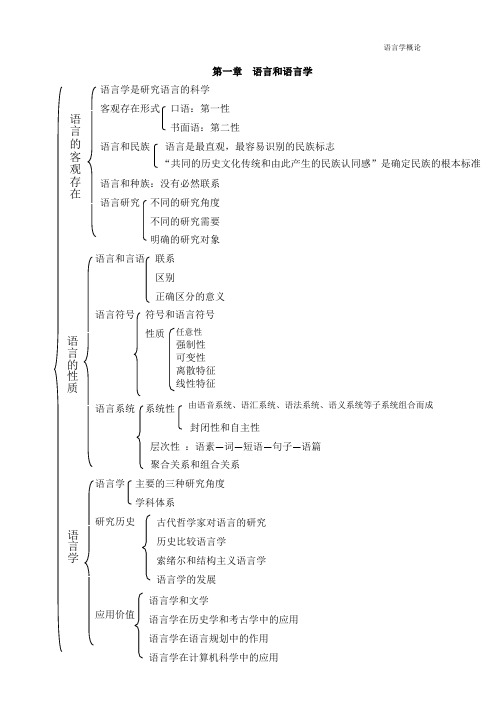
语言学概论 “共同的历史文化传统和由此产生的民族认同感”是确定民族的根本标准 由语音系统、语汇系统、语法系统、语义系统等子系统组合而成 第一章 语言和语言学
语言学是研究语言的科学
客观存在形式 口语:第一性 书面语:第二性 语言和民族 语言是最直观,最容易识别的民族标志 语言和种族:没有必然联系
语言研究 不同的研究角度
不同的研究需要
明确的研究对象
语言和言语 联系
区别
正确区分的意义
语言符号 符号和语言符号
性质
语言系统 系统性
封闭性和自主性
层次性 :语素—词—短语—句子—语篇 聚合关系和组合关系
语言学 主要的三种研究角度
学科体系
研究历史 应用价值 任意性
强制性 可变性
离散特征 线性特征 语言
的
客
观
存
在形
式语言的性质 古代哲学家对语言的研究
历史比较语言学
索绪尔和结构主义语言学
语言学的发展
语言学和文学
语言学在历史学和考古学中的应用
语言学在语言规划中的作用
语言学在计算机科学中的应用 语言学。
语言学概论知识梳理(期末重点)
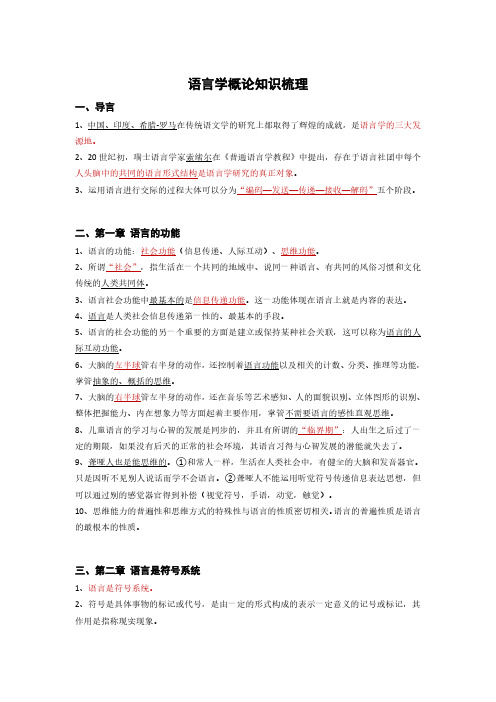
语言学概论知识梳理一、导言1、中国、印度、希腊-罗马在传统语文学的研究上都取得了辉煌的成就,是语言学的三大发源地。
2、20世纪初,瑞士语言学家索绪尔在《普通语言学教程》中提出,存在于语言社团中每个人头脑中的共同的语言形式结构是语言学研究的真正对象。
3、运用语言进行交际的过程大体可以分为“编码—发送—传递—接收—解码”五个阶段。
三、第二章语言是符号系统1、语言是符号系统。
2、符号是具体事物的标记或代号,是由一定的形式构成的表示一定意义的记号或标记,其作用是指称现实现象二、第一章语言的功能1、语言的功能:社会功能(信息传递、人际互动)、思维功能。
2、所谓“社会”,指生活在一个共同的地域中、说同一种语言、有共同的风俗习惯和文化传统的人类共同体。
3、语言社会功能中最基本的是信息传递功能。
这一功能体现在语言上就是内容的表达。
4、语言是人类社会信息传递第一性的、最基本的手段。
5、语言的社会功能的另一个重要的方面是建立或保持某种社会关联,这可以称为语言的人际互动功能。
6、大脑的左半球管右半身的动作,还控制着语言功能以及相关的计数、分类、推理等功能,掌管抽象的、概括的思维。
7、大脑的右半球管左半身的动作,还在音乐等艺术感知、人的面貌识别、立体图形的识别、整体把握能力、内在想象力等方面起着主要作用,掌管不需要语言的感性直观思维。
8、儿童语言的学习与心智的发展是同步的,并且有所谓的“临界期”:人出生之后过了一定的期限,如果没有后天的正常的社会环境,其语言习得与心智发展的潜能就失去了。
9、聋哑人也是能思维的。
①和常人一样,生活在人类社会中,有健全的大脑和发音器官。
只是因听不见别人说话而学不会语言。
②聋哑人不能运用听觉符号传递信息表达思想,但可以通过别的感觉器官得到补偿(视觉符号,手语,动觉,触觉)。
10、思维能力的普遍性和思维方式的特殊性与语言的性质密切相关。
语言的普遍性质是语言的最根本的性质。
3、符号包括形式和意义两方面,二者不可分离,相结合才构成符号,没有无意义的符号形式。
语言学教程[第一章语言学导论]山东大学期末考试知识点复习
![语言学教程[第一章语言学导论]山东大学期末考试知识点复习](https://img.taocdn.com/s3/m/b476bb6000f69e3143323968011ca300a6c3f6d3.png)
语言学教程[第一章语言学导论]山东大学期末考试知识点复习第一章语言学导论复习笔记Ⅰ.语言的定义语言是人类以口头交流的任意的符号系统。
该定义揭示了语言的五个要素:系统,任意,口头,符号,人类。
Ⅱ.语言的定义特征语言的定义特征是人类语言区别于其他动物交流系统的特点。
1.任意性二重性是指拥有两层结构的这种属性,底层结构是上层结构的组成成分,每层都有自身的组合规则。
二重性只存在于这样的系统之中,既有元素又有它们组合成的单位。
3.创造性创造性指语言的能产性,它能够使人造出和理解无穷的长句,其中很多句子是以前从未听过的。
4.移位性移位性是指人类语言可以让使用者在交际时用语言符号代表时间上和空间上并不可及的物体、事件和观点。
移位性赋予人们的概括和想象力使人类受益无穷。
5.文化传递性语言不是靠遗传,而是通过文化传递的。
6.互换性互换性是指人可以是信息的发出者,也可以是信息的接受者,即人作为说话者和听话者的角色是可以随意更换的。
Ⅲ.语言的起源1.圣经的记载语言是上帝的恩赐。
2.“汪汪”理论语言是模仿自然的声音,例如动物的叫声,如(鸭子)的刮刮声,嘎嘎声,布谷鸟的叫声。
3.“噗噗”理论语言起源于原始人共同劳动时发出的有节奏的哼哟声。
5.进化理论语言起源于劳动的过程,满足了社会的需求。
Ⅳ.语言的功能1.信息功能语言用来陈述某件事情,提供信息或用作推理。
信息功能是语言最重要的功能,一般出现在陈述句中。
2.人际功能人际功能是语言最重要的社会功能。
人们由此建立和维持他们的身份和社会地位。
3.施为功能语言的施为功能主要是用来改变人的社会地位,例如在婚礼、判刑,为孩子祈福和在首航仪式上为船命名、诅咒敌人。
在这些言语行为中,语言通常是非常正式的,甚至是仪式化的。
4.感情功能语言的感情功能是语言最有用的功能之一,因为它在改变听者赞成或反对某人、某物的态度上作用非常关键。
5.寒暄功能寒暄功能是指那些有助于确立和维持人际关系的表达,例如俚语、玩笑、行话、礼节性的问候、社会方言或地域方言的转用等。
语言学概论自学考试 知识点总结 详细版
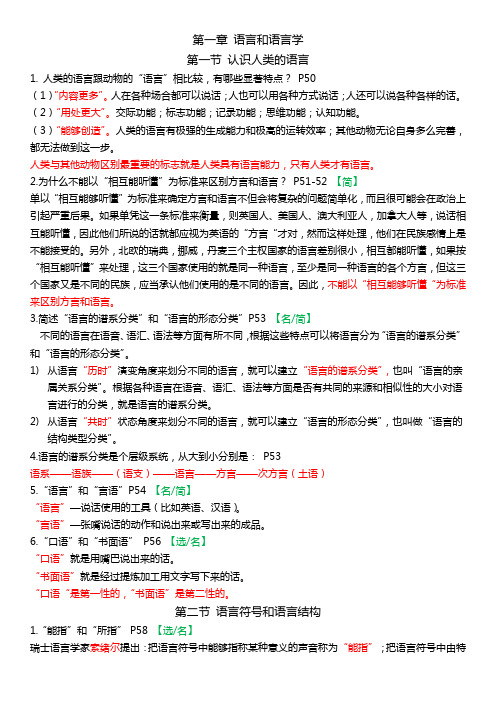
第一章语言和语言学第一节认识人类的语言1.人类的语言跟动物的“语言”相比较,有哪些显著特点?P50(1)“内容更多”。
人在各种场合都可以说话;人也可以用各种方式说话;人还可以说各种各样的话。
(2)“用处更大”。
交际功能;标志功能;记录功能;思维功能;认知功能。
(3)“能够创造”。
人类的语言有极强的生成能力和极高的运转效率;其他动物无论自身多么完善,都无法做到这一步。
人类与其他动物区别最重要的标志就是人类具有语言能力,只有人类才有语言。
2.为什么不能以“相互能听懂”为标准来区别方言和语言?P51-52【简】单以“相互能够听懂”为标准来确定方言和语言不但会将复杂的问题简单化,而且很可能会在政治上引起严重后果。
如果单凭这一条标准来衡量,则英国人、美国人、澳大利亚人,加拿大人等,说话相互能听懂,因此他们所说的话就都应视为英语的“方言“才对,然而这样处理,他们在民族感情上是不能接受的。
另外,北欧的瑞典,挪威,丹麦三个主权国家的语言差别很小,相互都能听懂,如果按“相互能听懂”来处理,这三个国家使用的就是同一种语言,至少是同一种语言的各个方言,但这三个国家又是不同的民族,应当承认他们使用的是不同的语言。
因此,不能以“相互能够听懂“为标准来区别方言和语言。
3.简述“语言的谱系分类”和“语言的形态分类”P53【名/简】不同的语言在语音、语汇、语法等方面有所不同,根据这些特点可以将语言分为“语言的谱系分类”和“语言的形态分类”。
1)从语言“历时”演变角度来划分不同的语言,就可以建立“语言的谱系分类”,也叫“语言的亲属关系分类”。
根据各种语言在语音、语汇、语法等方面是否有共同的来源和相似性的大小对语言进行的分类,就是语言的谱系分类。
2)从语言“共时”状态角度来划分不同的语言,就可以建立“语言的形态分类”,也叫做“语言的结构类型分类”。
4.语言的谱系分类是个层级系统,从大到小分别是:P53语系——语族——(语支)——语言——方言——次方言(土语)5.“语言”和“言语”P54 【名/简】“语言”—说话使用的工具(比如英语、汉语)。
语言学知识系统图解

4句法学范畴之间的关系---一致与支配
句子的种类---简单句、并列句和复合句
组合和聚合关系
结构语法直接成分分析
内向结构和外向结构
生成语法(略)
功能语法(略)
语义学的定义
命名论
概念论
意义理论语境论
使用论
行为论
利奇的意义七分法
意义的分类
其他意义分类法
同义关系
互补反义词
英语语言学各章节系统图解
语言的定义及定义的理解
语言的甄别性特征
语言语言的功能
语言的起源
1语言和语言学
语言学的定义及定义的理解
语言学普通语言学及其研究范围
常见的重要区别性概念
语音学的定义
听觉语音学
声学语音学
语音学分类(清辅音、浊辅音)
辅音描述(发音部位、发音方式、清浊性)
标音(宽式标音、严式标音)
发音语音学
分类(前、中、后元音)
元音描述(唇、舌位、开口度/舌高度、紧/松)
标音(宽式标音、严式标音)
2语音学
音系学最小对立体
音位、音位变体
音位理论自由变异
音位对立、区别性特征
音位分布、互补分布
音系学
序列规则
音系规则同化规则(顺同化、逆同化)
省略规则
超切分音位特征(音节、重音、声调、语调)
定义
形态基本模块:词素、形素、词素变体
5语义学反义关系等级反义词
词之间的意义关系关系反义词
上下义关系
一词多义
同音/同形异义
蕴含
预设
矛盾
句子之间的意义关系不一致
同义关系
语义异常
语义成分分析
语言学概论第一章语言与语言学笔记
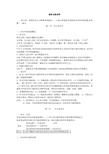
语言与语言学语言学:智慧而令人心醉神迷的探索--人类从野蛮到文明的进化中所使用的基本武器--语言。
第一节关于语言学一、语言学的发展概况1、语文学:研究目的:阅读古籍和语言教学。
古印度:公元前4世纪《巴尼尼语法》;古希腊:西方哲学的故乡;古中国:“小学”文字学《说文解字》、音韵学《广韵》、训诂学《尔雅》、第一部语法专著《马氏文通》。
2、历史比较语言学产生于19世纪初,用历史的方法和比较的方法研究语言,是语言学真正诞生的标志。
语言学从此摆脱了经学的附庸地位。
3、结构主义语言学,也叫普通语言学。
1916年费尔迪南·德·索绪尔《普通语言学教程》的出版标志着结构主义语言学的诞生。
这本著作是语言学史上的一个里程碑,影响极为深远。
索绪尔的语言学思想标志着人类语言学史的一个伟大的转折,索绪尔本人也被称为现代语言学之父。
4、转换生成语言学1957年,美国语言学家乔姆斯基的《句法结构》问世标志着转换生成语言学的诞生。
二、语言学1、定义:语言学是以人类所有语言作为研究对象的学科,研究人类语言的性质、结构、功能、发展演变规律。
2、语言学的分类标准:(1)功能角度:理论语言学和应用语言学;(2)具体研究对象:普通(一般)语言学/个别(专语、具体)语言学;(3)研究时段:共时语言学和历时语言学;(4)研究方法:描写语言学和对比语言学本课程的核心内容是讲授普通语言学的内容。
普通语言学是以全人类的语言为研究对象,研究语言的性质、功能、结构、规律。
3、本课程的特点是:(1)高度抽象;(2)涉及全球所有语言。
4、学习语言学的意义:(1)提高语言修养,使领悟、解释语言的能力增强。
(2)开拓自己的语言事业,增加自己的语言知识,更好的了解母语。
汉语: A、语音特点:①元音占优势;②无复辅音;③有音乐性的声调;B、语法:①汉语靠语序和虚词表达语法意义;②汉语有大量的量词;第二节什么是语言一、语言、言语首先区别语言和言语的是索绪尔。
语言学概论—重点知识总结
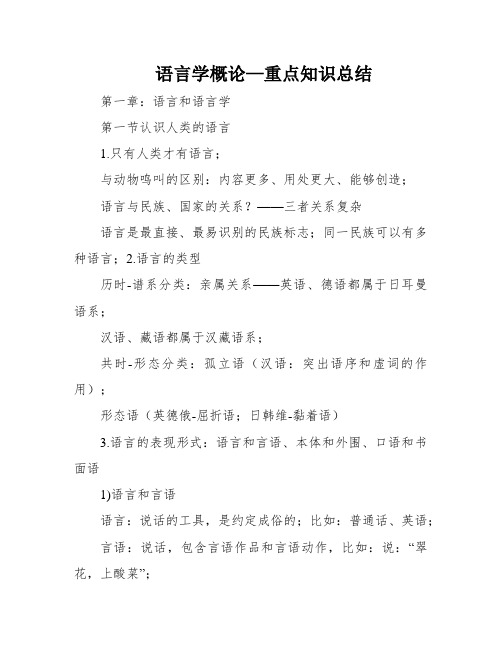
语言学概论—重点知识总结第一章:语言和语言学第一节认识人类的语言1.只有人类才有语言;与动物鸣叫的区别:内容更多、用处更大、能够创造;语言与民族、国家的关系?——三者关系复杂语言是最直接、最易识别的民族标志;同一民族可以有多种语言;2.语言的类型历时-谱系分类:亲属关系——英语、德语都属于日耳曼语系;汉语、藏语都属于汉藏语系;共时-形态分类:孤立语(汉语:突出语序和虚词的作用);形态语(英德俄-屈折语;日韩维-黏着语)3.语言的表现形式:语言和言语、本体和外围、口语和书面语1)语言和言语语言:说话的工具,是约定成俗的;比如:普通话、英语;言语:说话,包含言语作品和言语动作,比如:说:“翠花,上酸菜”;2)选择/名词:本体和外围本体:语言内部包含的要素,比如:语音、语法、语义;外围:语言和其他事物的关系,比如:语言和思维、语言和历史、语言和民族文化;3)口语和口语口语:说的话;第一性的,是书面语产生的基础书面语:写的字;第二性,在口语的基础上,加工提炼而成;第二节语言符号和语言结构1.语言符号必须同时具有表示具体意义的物质实体(红绿灯)和物质实体所表示的特定意义(红灯停绿灯行);2.语言的符号特性:能指和所指、约定和任意、不变和可变;1)能指和所指(口诀:能声所意)能指:把语言符号中能够指称某种意义的声音称为“能指”;所指:把语言符号中有特定声音表示的意义称为“所指”;2)约定和任意约定:人为的规定任意:符号表示意义没有必然联系,只需人人都认定或气就行3)不变和可变可变性的根本原因在于任意性3.语言的结构特性:线性和离散、组合和聚合、层次和层级1)线性和离散:构成语言结构的基础条件;线性:语言符号只能一个一个按工夫顺序成一条线排列;离散性:语言符合可以分解还原成一个一个的符号(词);2)组合和聚合组合:哪一个成分在前、哪一个成分在后的结构特征;(又叫句法功用)聚合:同一类成分可以相互替换的结构特性;3)层次和层级层次:一个小单位内部的成分组合叫做“层次”;(语素组合成词、词组合成词组、词组组合成句子)层级:各个小单位之间的联系叫做“层级”;(词和词一级的内在分别)第三节研究语言的科学1.学科研究的方向分类:本体研究、语言与心理、语言和使用;1)本体研究:对语音、语汇、语法、语义的研究;2)语言与心理研究:语言和心理之间的关系和相互影响;3)语言与应用研究:语言学和信息处理,把理论在实践中的运用;2.语言与哲学1)“名无固宜,约之以命,约定俗成谓之宜……”出自XXX的《正名篇》;2)“小学”包括:《文字学》、《音韵学》、《训诂学》;3.语言研究1)XXX的《通俗语言学教程》提出了“结构主义语言学”“能指和所指”,是结构语言学的奠基人;2)XXX:北美结构主义学家,间接成分分析法;3)乔姆斯基的“转换生成语法”,包括普遍语法、句法自治等观点;第二章语言的物质载体——语音第一节语音概说1.语音:“人说话的声音”,更严格地说,语音是人的发音器官发出的、用于人与人之间交际并表达一定意义的声音。
语言学概论 (00541)知识点汇总(第一章)
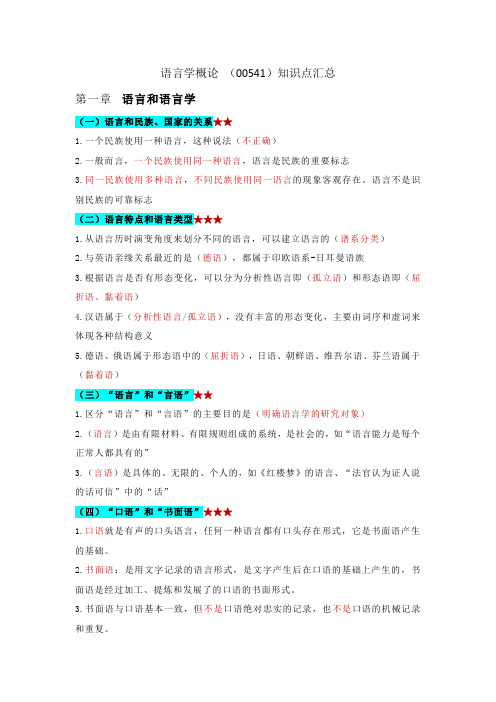
语言学概论(00541)知识点汇总第一章语言和语言学(一)语言和民族、国家的关系★★1.一个民族使用一种语言,这种说法(不正确)2.一般而言,一个民族使用同一种语言,语言是民族的重要标志3.同一民族使用多种语言,不同民族使用同一语言的现象客观存在。
语言不是识别民族的可靠标志(二)语言特点和语言类型★★★1.从语言历时演变角度来划分不同的语言,可以建立语言的(谱系分类)2.与英语亲缘关系最近的是(德语),都属于印欧语系-日耳曼语族3.根据语言是否有形态变化,可以分为分析性语言即(孤立语)和形态语即(屈折语、黏着语)4.汉语属于(分析性语言/孤立语),没有丰富的形态变化,主要由词序和虚词来体现各种结构意义5.德语、俄语属于形态语中的(屈折语),日语、朝鲜语、维吾尔语、芬兰语属于(黏着语)(三)“语言”和“言语”★★1.区分“语言”和“言语”的主要目的是(明确语言学的研究对象)2.(语言)是由有限材料、有限规则组成的系统,是社会的,如“语言能力是每个正常人都具有的”3.(言语)是具体的、无限的、个人的,如《红楼梦》的语言、“法官认为证人说的话可信”中的“话”(四)“口语”和“书面语”★★★1.口语就是有声的口头语言,任何一种语言都有口头存在形式,它是书面语产生的基础。
2.书面语:是用文字记录的语言形式,是文字产生后在口语的基础上产生的,书面语是经过加工、提炼和发展了的口语的书面形式。
3.书面语与口语基本一致,但不是口语绝对忠实的记录,也不是口语的机械记录和重复。
(五)“能指”和“所指”★★★★★1.属于符号的是(语言、文字、红绿灯、旗语)2.符号中能够指称某种意义的成分被称为(能指),符号所指的意义内容是(所指)3.语言符号的能指是(语音),语言符号的所指是(意义)4.首先提出“能指”和“所指”这对概念的语言学家是(索绪尔)5.能指和所指的关系是(不可分割)的,一旦分开,语言符号就不存在了。
(六)“约定”和“任意”★★★★★1.交通信号灯中红灯表示“停”的意思,红灯和“停”之间的关系是(约定的)2.语言符号的任意性是指(语言符号的物质实体和意义内容之间没有必然联系),即:声音和意义之间没有必然联系的理据关系,在语言符号产生之初,它的声音和意义的结合是任意的,是由社会约定俗成的,它们之间的关系是不可论证的3.语言符号具有可变性的根本原因在于语言符号的(任意性)4.语言符号的强制性是指(个人不能任意改变已经约定的符号)(七)“线性”和“离散”★★★1.语言结构的线性特征:语言符号的结构必须是按照时间顺序成一条线的样子排列。
语言学概论 第1章 主要知识点

语言系统 语言(狭义) 语言(广义) 言语活动 言语作品 言语
法庭上应该说普通话。 轮到你作证时你才说话。 法庭认为你的话有说服力。
语言 ≠ 言语
第一节语言的性质和范围
语言与言语的主要区别:
语言是抽象的、社会的、现成的、有限的、 稳定的; 言语是具体的、个人的、临时的、无限的、 多变的。 语言来自于言语,依存于言语。 语言又制约着言语,指导人们进行言语实践。
依附性副语言(交通信号等) 独立性副语言(自然体态语等)
语言与副语言的关系
第一节语言的性质和范围
二、语言的范围 (四)自然语言与人工语言 自然语言:由社会群体共同创造的、在日 常交际活动中逐渐自然形成和发展的语言。 人工语言:个别人或少数人人工设计出来 的语言。
第一节语言的性质和范围
第一章 语言和语言学
廖继莉 华中师范大学文学院语言学系 E-mail: liaojili@
内容概要
语言的性质和范围 语言的结构 语言的功能 语言学及其发展
第一节语言的性质和范围
一、语言的性质 (一)语言是什么? 从结构上看,语言是一个复杂的符号系统。 从功能上看,语言最重要的功能是社会交 际功能和思维认知功能。 定义:语言是一种复杂的符号系统,是人 类进行社会交际和思维认知的工具。
(五)语言的其他属性 3、模糊性 语言的类与类之间没有明确的界限,而是 逐渐过渡的。 例:少年,青年,中年,老年
第一节语言的性质和范围
二、语言的范围 你的语言太生硬。 莎士比亚的语言,鲁迅的语言 英语,汉语 口头语言,书面语言,商务语言 他研究语言。
第一节语言的性质和范围
语言学框架

Chapter 1 In troducti on1.1 What is linguistics?1.1.1 Defi nitio n★ Lin guistics is gen erally defi ned as the scie ntific study of Ian guage.1.1.2 The scope of linguistics 语言学范畴Pho netics 语音学/Pho no logy 音系学/Morphology 形态学/Syn tax 句法学/Sema ntics 语义学/Pragmatics语用学Macrolinguistics 宏观语言学:sociolinguistics 社会语言学/Psycholinguistics 心理语言学/Applied linguistics 应用语言学1.1.3 Important distinctionsin linguistics语言学中重要区别1) prescriptive vs. descriptive 规定性与描述性2) synchronic vs. diachronic 共时性与历时性 | SaussurS3) speech & writi ng 口语和书面语4) langue & parole 语言(抽象)和言语(具体)| Saussur^5) competence & performanee 能力和运用 | Chomsky6) traditi onal grammar & moder n」in guistics 传统语法和现代语言学★索绪尔一一现代语言学之父1.2 What is language?1.2.1 Definition of language★ Lan guage is a system of arbitrary vocal symbols used for huma n com muni cati on.1.2.2 Design featuresof Ianguage语言的区别性特征丨Hockett^(1) Arbitrari ness任意性:符号的音与义之间没有逻辑联系。
语言学纲要笔记 第一章:语言学概论语言学纲要笔记 第一章:语言学概论

hunters歧义。
转换的意思是:一个长句子可以转换成各种短句子 例如:无形的上帝创造了有形的世界。这句话是 有三个核心句子构成:
上帝创造了世界 上帝是无形的 世界是有形的
转换语法可以分解the shooting of the hunters的 义。因为它可以转换为: 1 they shoot the hunters。 2 the hunters shoot a tiger。
• 数理语言学:用代数、计算机科学、统计学等领 域中的概念和方法研究语言的数学属性等问题。
• 计算语言学:用计算机科学的技术和概念研究语 言,特别是研究语言的理解和处理、机器翻译、 情报检索等问题
• 实验语音学:用各种实验仪器分析语音,研究语 音的识别和合成等问题。
第一章 语言的社会功能 第一节 语言是人类最重要的交际工具
一部解释词义的书,是中国古代的词典。
• 扬雄《方言》 、刘熙《释名》 • ——小学:文字、音韵、训诂
印度的语言研究
古代印度人研究语言主要是为了保存口头相传的婆罗 门教义《吠陀经》的原文和梵语文学,使之不致因时间的 流逝而面目全非。例:波尼尼(潘尼尼、巴尼尼 Pānini) 《八书》。
古印度语言学最突出的成就表现在语音学上。例如:
雅科布逊(1896年— 1982年) (区别特征学 说)《语音分析初探》(1951)
马德修斯(1882年—1945年)
该学派于1926年创建。其研究重点是:把语言 作为一种功能体系来进行研究和分析。特别重视音
• 哥本哈根学派 • 成立时间:1931 • 代表人物:叶尔姆斯列夫 • 代表作:《结构语言学》(布龙达尔1931)《语言理论
导论》(叶尔姆斯列夫 1953)、 《语符学纲要》(乌尔达尔 1957)、
语言学第一二章知识点
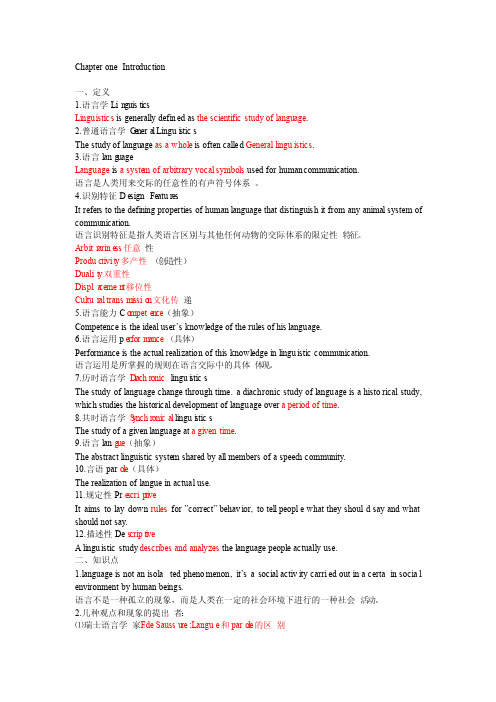
Chapte r one Introd uctio n一、定义1.语言学Lin guisti csLingui stics is genera lly define d as the scient ificstudyof langua ge.2.普通语言学G e nera l Lingui s ticsThe studyof langua ge as a wholeis oftencalled Genera l lingui stics.3.语言lang uageLangua ge is a system of arbitr ary vocalsymbol s used for humancommun icati on.语言是人类用来交际的任意性的有声符号体系。
4.识别特征De signFeaturesIt refers to the defini ng proper tiesof humanlangua ge that distin guish it from any animal system of commun icati on.语言识别特征是指人类语言区别与其他任何动物的交际体系的限定性特征。
Arbitrarine ss任意性Productivit y多产性(创造性)Dualit y双重性Displa cemen t移位性Cultural transm i ssio n文化传递5.语言能力Co mpete n ce(抽象)Compet enceis the idealuser‘sknowle dge of the rulesof his langua ge.6.语言运用pe rform ance(具体)Perfor mance is the actual realiz ation of this knowle dge in lingui sticcommun icati on.语言运用是所掌握的规则在语言交际中的具体体现。
语言学基础知识
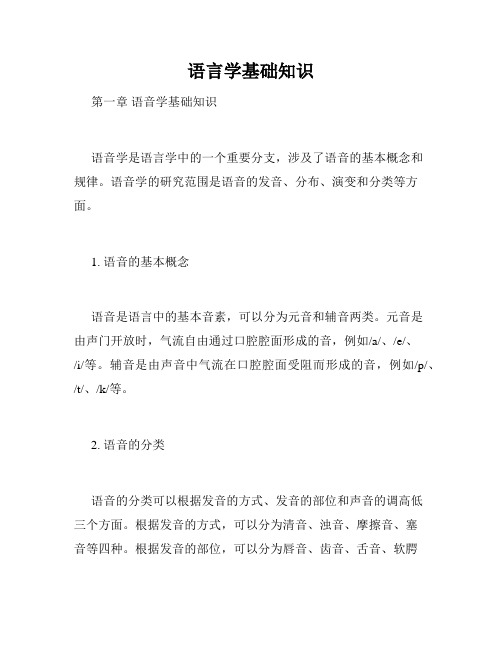
语言学基础知识第一章语音学基础知识语音学是语言学中的一个重要分支,涉及了语音的基本概念和规律。
语音学的研究范围是语音的发音、分布、演变和分类等方面。
1. 语音的基本概念语音是语言中的基本音素,可以分为元音和辅音两类。
元音是由声门开放时,气流自由通过口腔腔面形成的音,例如/a/、/e/、/i/等。
辅音是由声音中气流在口腔腔面受阻而形成的音,例如/p/、/t/、/k/等。
2. 语音的分类语音的分类可以根据发音的方式、发音的部位和声音的调高低三个方面。
根据发音的方式,可以分为清音、浊音、摩擦音、塞音等四种。
根据发音的部位,可以分为唇音、齿音、舌音、软腭音、硬腭音、喉音等六种。
根据声音的调高低,可以分为高、低、中、升调和降调等五种。
3. 语音的演变语音的演变是指人类历史上语音系统的变化。
语音的演变可以分为语言演变和语音演变两种。
语言演变是指一个语言从古老的阶段到现代的阶段的演变。
语音演变是指一个语言在发音上的变化。
第二章词汇学基础知识词汇是一种语言的基本元素,是用来表达思想和意义的词语。
词汇有很多种类,包括独立词、依存词、派生词、合成词等。
1. 词汇的分类词汇可以按照词义、构词方式和语法功能进行分类。
按照词义,可以分为实义词和虚词两种。
实义词是有具体含义的单词,例如“桌子”、“衣服”等。
虚词则是语言中一些无实际含义,起到构词、语法等方面作用的词语,例如“的”、“是”等。
根据构词方式,可以分为派生词、合成词和构词词等。
根据语法功能,可以分为名词、动词、形容词、副词、代词、连词、介词等。
2. 词汇的记忆和运用词汇的记忆和运用是外语学习中的一大难点。
记忆词汇要注意搭配和应用场合,多做词汇扩展练习并巩固记忆。
在实际应用中,需要根据语境和情境进行运用。
第三章语法学基础知识语法学是语言学中的重要分支,主要研究语言的形式结构和规则。
语法学的研究内容包括词汇和句子两个层面。
1. 词类和语法关系词类是指单词属于哪一种语法类别,包括名词、动词、形容词等。
- 1、下载文档前请自行甄别文档内容的完整性,平台不提供额外的编辑、内容补充、找答案等附加服务。
- 2、"仅部分预览"的文档,不可在线预览部分如存在完整性等问题,可反馈申请退款(可完整预览的文档不适用该条件!)。
- 3、如文档侵犯您的权益,请联系客服反馈,我们会尽快为您处理(人工客服工作时间:9:00-18:30)。
Chapter 1Invitations to Linguistics1.1 Why Study Language?1.Some myths about language2.Some fundamental views about language3.Some concrete demonstrations to show Linguistics’importance1.2 What is Language?1. Language “is not to be confused with human speech, of which it is only a definite part, though certainly an essential one. It is both a social product of the faculty of speech and a collection of necessary conventions that have been adopted by a social body to permit individuals to exercise that faculty”.--Ferdinand de Saussure (1857-1913): Course in General Linguistics (1916) 2. “Language is a purely human and non-instinctive method of communicating ideas, emotions and desires by means of voluntarily produced symbols.”--Edward Sapir (1884-1939): Language: An Introduction to the Study of Speech (1921)3. “A language is a system of arbitrary vocal symbols by means of which a social group co-operates.”--Bernard Bloch (1907-1965) & George Trager (1906-1992): Outline of Linguistic Analysis (1942)4. “A language is a system of arbitrary vocal symbols by means of which the members of a society interact in terms of their total culture.”--George Trager: The Field of Linguistics (1949)5. “From now on I will consider language to be a set (finite or infinite) of sentences, each finite in length and constructed out of a finite set of elements.”--Noam Chomsky (1928- ): Syntactic Structures (1957)6. Language is “the institution whereby humans communicate and interact with each other by means of habitually used oral-auditory arbitrary symbols.”--Robert A. Hall (1911-1997): Introductory Linguistics (1964)7.“Language is a system of arbitrary vocal symbols used for human communication.”--Ronald Wardhaugh: Introduction to Linguistics (1977)8. “Language is a means of verbal communication.”—It is instrumental in that communicating by speaking or writing is a purposeful act.—It is social and conventional in that language is a social semiotic and communication can only take place effectively if all the users share a broad understanding of human interaction including such associated factors as nonverbal cues, motivation, and socio-cultural roles. -- Our textbook (2006)9. Language is a system of arbitrary vocal symbols used for human communication.1.3 Design Features of LanguageLanguage distinguishes human beings from animals in that it is far more sophisticated than any animal communication system.Human language is ‘unique’1. Arbitrariness①Definition②Different levels of arbitrarinessa.Arbitrary relationship between the sound of a morpheme and its meaningb.Arbitrariness at the syntactic levelc.Arbitrariness and convention2. Duality①Definition②Two levels of structures in languageThe secondary level (sounds, meaningless)The primary level (words, meaningful)③Hierarchy of language3. Creativity①Language is resourceful because of its duality and its recursiveness. We can useit to create new meanings.②The recursive nature of language provides a potential to create an infinitenumber of sentences. For instance:---He bought a book which was written by a teacher who taught in a school which was known for its graduates who ..4. Displacement①Definition②Two examples③The advantage of displacement1.4 Origin of language1.The “bow-wow”theory2.The “pooh-pooh”theory3.The “yo-he-ho”theory1.5 Functions of language1.Jakobson’s classificationContextREFERENTIALAddresser EMOTIVE(e.g. intonation showing anger)MessagePOETIC(e.g. poetry)AddresseeCONATIVE(e.g. imperatives andvocatives)ContactPHATIC(e.g. Good morning!)CodeMETALINGUAL(e.g. Hello, do you hear me?)2.Halliday’s classification①Three metafunctions of language②Seven categories of language functions by observing child languagedevelopment3.The author’s introduction①Informative②Interpersonal Function③Performative④Emotive Function⑤Phatic Communion⑥Recreational Function⑦Metalingual Function1.6 What is Linguistics?Linguistics is usually defined as the science of language or, alternatively, as the scientific study of language.1.7 Main branches of Linguistics1.Phonetics2.Phonology3.Morphology4.Syntax5.Semantics6.Pragmatics1.8 Macrolinguistics1.Psycholinguistics2.Sociolinguistics3.Anthropological Linguisticsputational Linguistics1.9 Important distinctions in Linguistics1.Descriptive vs. Prescriptive2.Synchronic vs. Diachronicngue & Parolepetence and Performance。
